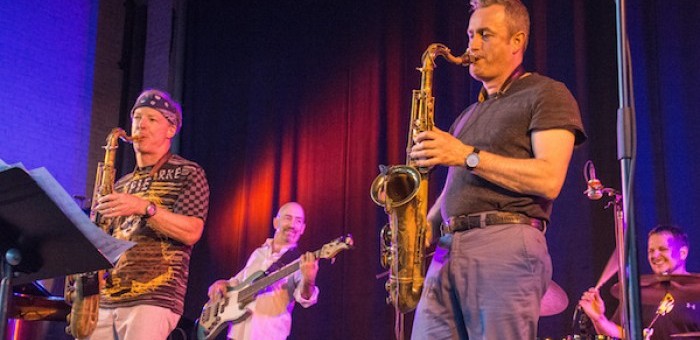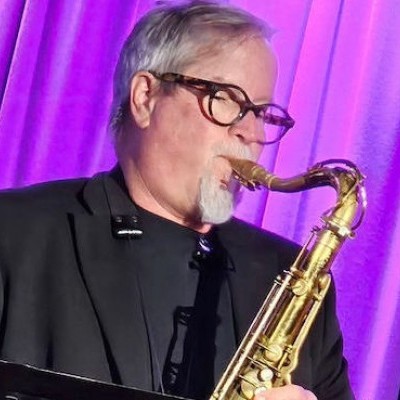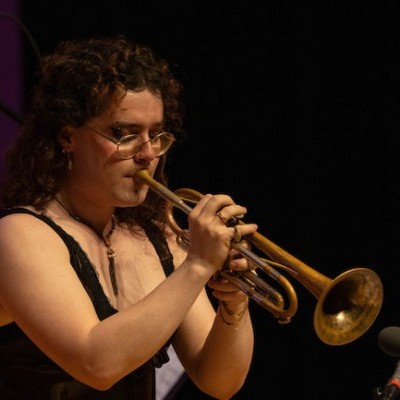Oct 28, 2025 10:47 AM
In Memoriam: Jack DeJohnette, 1942–2025
Jack DeJohnette, a bold and resourceful drummer and NEA Jazz Master who forged a unique vocabulary on the kit over his…

Saxophonists Bill Evans (left) and Tommy Smith perform at Harro East Ballroom in Rochester, New York.
(Photo: Rochester International Jazz Festival/Don Ver Ploeg)The Xerox Rochester International Jazz Festival is now up to its 16th edition, completely taking over the downtown business and arts center of the city, in much the same fashion as the Detroit and Montreal equivalents. So far upstate in New York that it’s virtually at the Canadian border, Rochester’s jazz festival operates on all economic levels of entry.
The nightly big-name shows take place at the glorious Eastman Theatre, and multiple stages present medium-sized ticketed gigs that are accessible either individually, or with a multi-show Club Pass. These represent a high count of sets already, but then there’s the added bonus of a prodigious number of free admission events on the various street-stages. This year, the show-count topped 325 performances, with 95 of those being freebies. Attendance over the festival’s nine days was estimated at 200,000.
Your reviewer was in town for five days (June 27–July 1) during the festival’s climactic stretch. The Scottish saxophonist Tommy Smith has become a regular here, generally appearing in fresh settings each time. But this year, Smith joined saxophonist Bill Evans’s band to showcase the funk/fusion aspects of his playing in the acoustically challenging Harro East Ballroom.
This tenor tussle developed in front of the electric guitar and bass strut of the Evans crew, although the leader sometimes took time out to color the palette with some acoustic piano asides. The tenor battling was good-natured, with the overall retro sound harking back to the 1980s, when Evans was playing with Miles Davis.
Smith and Evans engaged in a dialogue while the rest of the band paused, the Scot honking in pain with Evans matching and heightening every agonized phrase. A strutting, film noir-ish theme emerged, and the pair turned to smoothness, smearing deeply across the satin spread. Dean Brown led a storming rock section with a fierce guitar solo, and Keith Carlock maintained a complicated hardness throughout. The next day, Smith gave a solo recital in the Lyric Theatre, operating the most extreme contrast possible, sticking to standards and using the churchy acoustic to affect the duration and phrasing of his melodic developments.
Two of this festival’s well-established themes focus on artists imported from the U.K. and Norway, with two sets each night in Christ Church and the Lutheran Church Of The Reformation, respectively. Binker & Moses arrived from London, and are literally a duo of saxophonist Binker Golding and drummer Moses Boyd. Reaching a musical boiling point early on, Golding made a robust tenor squall, pushing forcefully against Boyd’s big, crashing drum sound. They cut to a sharp quiet before escalating this bluesy progress once more.
The duo’s only drawback is that they have a tendency to repeat a cycle of quiet-then-loud, introspective-then-inflamed, making the results of their set sometimes too predictable. Perhaps a small band structure (as heard on the second disc of their debut album) would allow Golding and Boyd to develop some more varied compositional structures on the live stage.
Meanwhile, in the Lutheran church, Gard Nilssen’s Acoustic Unity was displaying its wares, as one of Norway’s best new bands. The trio of Nilssen (drums), Ole Morten Vågan (bass) and André Roligheten (saxophones) concentrated on the contents of debut album Firehouse. Roligheten made scattered, twisting outbursts, punctuated by the bass and drums forging a high-speed walking motion, acting as a vehicle for tenor sprinting. Vågan boasts one of the harshest bass tones ever heard, delivering an extremely percussive solo, the taut action on his strings demanding a brutal strength from his fingers. Roligheten blew on soprano and tenor at the same time, the latter employed for a reeling solo, with Vågan’s bass in free rockabilly mode.
It later emerged that the saxophonist was feeling extremely ill during this first set, with a serious bout of food poisoning. When he was sitting on a pew to the side, letting the bass and drums fly off, this merely seemed like a well-judged improvising strategy, and so the trio dealt very well with this grim circumstance. As it happened, they were forced to cancel the second set.
Other peaks included trombonist Ryan Keberle & Catharsis at the cozy Little Theatre, passing from song-based numbers (led by singer-guitarist Camila Meza) to free-form constructions (Scott Robinson shining on these occasions). The New Orleans funk rockers Bonerama were limp in the Ballroom for an early evening set, but fired up on the following evening, closer to midnight in the Big Tent, where their accustomed energy was blasting through all three trombones, as well as Matt Perrine’s equally agile sousaphone.
Dakha Brakha was the festival’s strangest combo, a Ukrainian multi-instrumentalist quartet that marries rustic folk harmonies to electronica without managing to dilute their purist rootsiness. The best free stage set arrived on the final night, as the Canadian blues singer-guitarist Colin James rocked the avenue with a performance that didn’t let up for a second.
Two of the festival’s biggest gigs at the Eastman Theatre were by gospel singer Mavis Staples and the English progressive rockers King Crimson. For Staples, her onstage banter was almost as important as the singing, as she was in a particularly mischievous mood, cracking jokes and urging the capacity audience to participate, without the tiresome results that many performers deliver in this area. Lead guitarist Rick Holmstrom also added a pivotal degree of twanging, searing, note-bending solo action, and two of the highlight songs just happened to be among the most successful in the Staple Singers’ canon, “I’ll Take You There” and the Talking Heads cover “Slippery People”.
At the opposite end of the scale, guitarist Robert Fripp doesn’t believe in talking to his audience, and has a strict no-photography edict in place. Neither of these factors prevented King Crimson from delivering a majestic set, the complete festival highlight. Due to the structural rules of the Eastman, the band couldn’t play their full set, so offered a tighter, edited 90 minutes, with a 15-minute encore of “21st Century Schizoid Man.” This is one of the best, and most dynamically complicated, rock ’n’ roll songs, negotiated here in primal, headbanging glory.
Three drummers ranged across the front of the stage, finely arranged so that they worked together, rather than doing battle. Fripp reared up for repeated solos, which were overloaded with his signature tonal swoops, and there was a marked return to Crimson’s mid-1970s period, particularly the Red album. The frequent roaring of Mel Collins on baritone (just one horn among his armory of saxophones and flutes) more than justified Crimson’s place at a jazz festival, if such credentials were desired. DB

Jack DeJohnette boasted a musical resume that was as long as it was fearsome.
Oct 28, 2025 10:47 AM
Jack DeJohnette, a bold and resourceful drummer and NEA Jazz Master who forged a unique vocabulary on the kit over his…

“I’ve told students, ‘I don’t mind if you use AI for this or that project,’” says MIT’s Pascal Le Boeuf. “‘But you need to tell me.’”
Sep 18, 2025 11:14 AM
A standard joke when it comes to discussing artificial intelligence, or AI, is that it’s developing so rapidly that…

Chuck Manning Works for NASA … and plays jazz.
Sep 18, 2025 11:23 AM
Congratulations! After years of study, you’ve earned your degree in jazz performance. But let’s face it: Making a…

Always a sharp dresser, Farnsworth wears a pocket square given to him by trumpeter Art Farmer. “You need to look good if you want to hang around me,” Farmer told him.
Sep 23, 2025 11:12 AM
When he was 12 years old, the hard-swinging veteran drummer Joe Farnsworth had a fateful encounter with his idol Max…

“Make time and energy to meet people and make friends,” suggests Millie Ahearn, a student at DePaul University.
Sep 18, 2025 11:32 AM
For many students, the transition into a collegiate jazz program can feel overwhelming — new peers, unfamiliar…